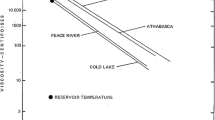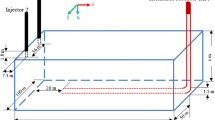Abstract
There are two basic requirements for heavy-oil recovery processes: first, mobilize the bitumen, and second, have a drive mechanism deliver the mobilized bitumen to a production wellbore. In situ combustion has the potential to be an important heavy-oil recovery method. Before design of in situ combustion recovery processes can start, it is necessary as a first step to understand the kinetics of various complex chemical reactions and determine kinetic constants associated with the reactions. Even with modern reservoir simulation capabilities, this is a significant challenge. In this research, an Athabasca bitumen combustion tube experiment, conducted by the ISC Research Group at the University of Calgary, was history matched by using a reservoir thermal simulator to determine a set of kinetic parameters as well as the transport parameters for the system. The main results of the history match was a match of air injection rate, bitumen and gas production volumes, average product gas compositions, temperature profiles along the tube through time, and pressure. Gridding sensitivities were examined to determine if the derived kinetic and transport parameters were dependent on gridblock size. The results revealed that the grid was refined enough to sufficiently capture thermal, mass transfer, and reaction length scales. After this single match was achieved, the same constants were used to successfully predict several other combustion tube experiments. The results suggest that the fuel (coke) for high-temperature oxidation (HTO) originates mainly from low-temperature oxidation (LTO) and not from thermal cracking. This implies that the major control on HTO is upstream oxygen transfer into the LTO region. If LTO does not occur, then a relatively small amount of coke is deposited in the matrix due to thermal cracking and this may be insufficient to start or sustain HTO.














Similar content being viewed by others
References
Adegbesan, K.O., Donnelly, J.K., Moore, R.G., and Bennion, D.W., 1987. Low-Temperature-Oxidation Kinetic Parameters for In Situ Combustion: Numerical Simulation. SPE Reserv. Eng., 2(4): 573-582. doi:10.2118/12004-PA.
Agca, C., and Yortsos, Y.C., 1985. Steady-state analysis of in situ combustion. SPE Paper 13624, p. 347–362
Bagci, S., 1998. Estimation of combustion zone thickness during in situ combustion processes. Energy Fuels, 12(6): 1153-1160. doi:10.1021/ef980013m.
Bagci, S., 2005. Effect of clay content on combustion reaction parameters. Energy Sources, 27(6): 579-588.
Bagci, S. and Kok, M.V., 2004. Combustion reaction kinetics studies of Turkish crude oils. Energy Fuels, 18 (5): 1472-1481. doi:10.1021/ef040014g.
Belgrave, J. D. M., Bennion, D. W., Moore, R. G., Gie, D. N., and Ursenbach, M. G., 1986a. Burnt report of combustion tube tests. A.O.S.T.R.A. No. 50 – Athabasca No. 45. Department of Chemical and Petroleum Engineering, University of Calgary.
Belgrave, J. D. M., Bennion, D. W., Moore, R. G., Gie, D. N., and Ursenbach, M. G., 1986b. Burnt report of combustion tube tests. A.O.S.T.R.A. No. 51 – Athabasca No. 46. Department of Chemical and Petroleum Engineering, University of Calgary
Belgrave, J. D. M., Bennion, D. W., Moore, R. G., Gie, D. N., and Ursenbach, M. G., 1986c. Burnt report of combustion tube tests. A.O.S.T.R.A. No. 52 – Athabasca No. 47. Department of Chemical and Petroleum Engineering, University of Calgary
Belgrave, J. D. M., Bennion, D. W., Moore, R. G., Gie, D. N., and Ursenbach, M. G., 1986d. Burnt report of combustion tube tests. A.O.S.T.R.A. No. 54 – Athabasca No. 49. Department of Chemical and Petroleum Engineering, University of Calgary
Belgrave, J. D. M., Bennion, D. W., Moore, R. G., Gie, D. N., and Ursenbach, M. G., 1986e. Burnt report of combustion tube tests. A.O.S.T.R.A. No. 55 – Athabasca No. 50. Department of Chemical and Petroleum Engineering, University of Calgary
Belgrave, J. D. M., Moore, R. G., Ursenbach, M. G., and Bennion, D. W., 1990. A comprehensive approach to in situ combustion modeling. SPE Paper 20250, p. 98–107
Bousaid, I.S. and Ramey, H.J., 1968. Oxidation of crude oil in porous media. SPE J., 8(2): 137-148.
Celebioglu, D. and Bagci, S., 2002. The effects of metallic catalysts on light crude oil oxidation in limestone medium. Fuel Process. Technol. 79(1): 29-49. doi:10.1016/S0378-3820(02)00098-X.
CMG, 2007. STARSTM user guide: advanced process and thermal reservoir simulator.
Dechelette, B., Heugas, O., Quenault, G., Bothua, J., and Christensen, J.R., 2006. Air injection-improved determination of the reaction scheme with ramped temperature experiment and numerical simulation. J. Can. Petrol. Tech., 45(1): 41-47.
Dubdub, I., Hughes, R., and Price, D., 1990. Kinetics of in situ combustion of Athabasca tar sands studied in a differential flow reactor. Chem. Eng. Res. Des., 68(4): 342-349.
Fassihi, M. R., Brigham, W. E., and Ramey, H. J., 1980. The frontal behaviour of in situ combustion. SPE Paper 8907
Fassihi, M.R., Brigham, W.E., and Ramey, H.J., 1984a. Reaction kinetics of in situ combustion: part I—observations. SPE J., 24(6): 399-407.
Fassihi, M.R., Brigham, W.E., and Ramey, H.J., 1984b. Reaction kinetics of in situ combustion: part II – modeling. SPE J., 24(4): 408-416.
Freitag, N. P. and Verkoczy, B., 2005. Low-Temperature Oxidation of Oils in Terms of SARA Fractions: Why Simple Reaction Models Don’t Work. J. Can. Petrol. Technol., 44(3): 54-61.
Galas, C.M.F. and Ejiogu, G.C., 1993. Enhancement of in-situ combustion by steam stimulation of production wells. SPE Reserv. Eng., 8(4): 270-274. doi:10.2118/22646-PA.
Gerritsen, M., Kovscek, A., Castanier, L., Nilsson, J., Younis, R., and He, B., 2004. Experimental investigation and high resolution simulator of in situ combustion processes; 1. Simulator design and improved combustion with metallic additives. SPE Paper 86962
Hallam, R. J., 1991. Operational techniques to improve the performance of in situ combustion in heavy-oil and oil-sand reservoirs. SPE Paper 21773
Hayashitani, M., Bennion, D. W., Donnelly, J. K., and Moore, R. G., 1978. Thermal cracking models for Athabasca oil sands oil. SPE Paper 7549
Husky, 2007. Submission to the EUB on the gas over bitumen hearing for the Caribou, Cold Lake Reservoir. Available at www.ercb.ab.ca.
Jia, N., Moore R.G., Mehta S.A., Van Fraassen K., Ursenbach M.G., and Zalewski E., 2005. Compositional changes for Athabasca bitumen in the presence of oxygen under low temperature conditions. J. Can. Pet. Technol., 44(9): 51-57.
Jia, N., Moore, R.G., Mehta, S.A., Ursenbach, M.G., and Hancock, M., 2006. Kinetic modelling of thermal cracking and low temperature oxidation reactions. J. Can. Petrol. Technol., 45(9): 21-28.
Kalogerakis, N. and Luus, R., 1983. Improvement of Gauss-Newton method for parameter estimation through the use of information index. Ind Eng Chem Fundam, 22(4): 436-455. doi:10.1021/i100012a015.
Kok, M.V., 2006. Effect of clay on crude oil combustion by thermal analysis techniques. J. Therm. Anal. Calorim., 84(2): 361–366. doi:10.1007/s10973-005-7153-2.
Kok, M.V., 2006. Kinetics of crude oil combustion. J. Therm. Anal. Calorim., 83(2): 445–449. doi:10.1007/s10973-005-7152-3.
Kok, M.V. and Bagci, S., 2004. Characterization and kinetics of light crude oil combustion in the presence of metallic salts. Energy Fuels, 18(5): 858-865. doi:10.1021/ef0301755.
Kumar, M. and Garon, A.M., 1991. An experimental investigation of the fire flooding combustion zone. SPE Reserv. Eng., 6(1): 55-61.
Le Thiez, P.A. and Lemonnier, P.A., 1990. An in situ combustion reservoir simulator with a new representation of chemical reactions. SPE Reserv. Eng., 5(3): 285-292. doi:10.2118/17416-PA.
Moore, R.G., Bennion, D.W., Belgrave, J.D.M., Gie, D.N., Ursenbach, M.G., 1990. New insights into enriched-air in situ combustion. J Pet Technol, 42(7): 916-923. doi:10.2118/16740-PA.
Moore, R.G., Laureshan, C.J., Ursenbach, M.G., Mehta, S.A., and Belgrave, J.D.M., 1999. Combustion/Oxidation Behavior of Athabasca Oil Sands Bitumen. SPE Reserv. Eval. Eng., 2(6): 565-571. doi:10.2118/59483-PA.
Moore, R. G., Mehta, S. A., Ursenbach, M. G., Gutierrez, D., and Skoreyko, F., 2008. The challenge of predicting field performance of air injection projects based on laboratory and numerical modelling, in Canadian International Petroleum Conference/SPE Gas Technology Symposium 2008 Joint Conference, Paper No. 2008-158
Perry, R.H., Green, D.W., and Maloney, J.O., 1997. Perry’s Chemical Engineers’ Handbook – 7 th Edition. New York: McGraw-Hill
Petrobank Energy and Resources Ltd., 2003. Application for approval of the WHITESANDS experimental pilot project. Submitted to the Alberta Energy and Utilities Board and Alberta Environment. Available at www.ercb.ab.ca.
Pratt, M., 1986. Thermal recovery. SPE Monograph Volume 7, Henry L. Doherty Series: SPE, Dallas, TX
Sequera Marin, B. M., 2007. Numerical simulation of low temperature oxidation reactions of Athabasca bitumen using SARA fractions. M.Sc. Thesis, University of Calgary
Stipanov, J., 1999. A kinetic model of hydrocarbon fraction reactions during the low and high-temperature oxidation of Athabasca bitumen. M.Sc. Thesis, University of Calgary
Thomas, F. B., Moore, R. G., and Bennion, D. W., 1985. Kinetics parameters for the high-temperature oxidation of in situ combustion coke. J. Can. Petrol. Technol., v. 24, p. 60–67.
Yaws, C.L., 1999. Chemical Properties Handbook. New York: McGraw-Hill
Acknowledgements
The authors wish to acknowledge the financial support from Natural Sciences and Engineering Council of Canada (NSERC) for this research. We also wish to thank to Alberta Ingenuity Centre for In Situ Energy (AICISE) and Institute for Sustainable Energy, Environment and Economy (ISEEE) of University of Calgary for support.
Author information
Authors and Affiliations
Corresponding author
Rights and permissions
About this article
Cite this article
Yang, X., Gates, I.D. Combustion Kinetics of Athabasca Bitumen from 1D Combustion Tube Experiments. Nat Resour Res 18, 193–211 (2009). https://doi.org/10.1007/s11053-009-9095-z
Received:
Accepted:
Published:
Issue Date:
DOI: https://doi.org/10.1007/s11053-009-9095-z




